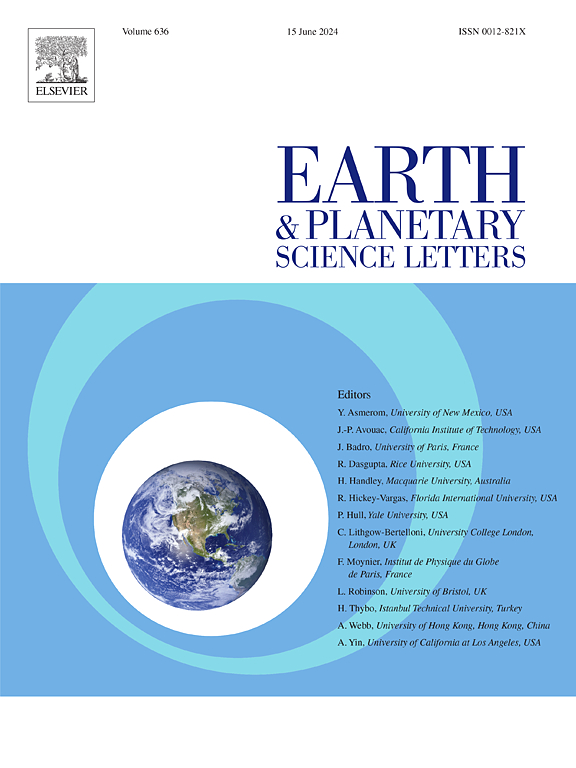Complex basalt evolution in the Chang'e-6 landing area
IF 4.8
1区 地球科学
Q1 GEOCHEMISTRY & GEOPHYSICS
引用次数: 0
Abstract
China's Chang'e-6 (CE6) sample return mission targeted the southern part of the Apollo basin inside the South Pole-Aitken (SPA) basin on the lunar farside. The spectrally peculiar mare basalts in the CE6 landing area had undergone complex evolution: (1) At least three mare floodings with low- to intermediate-titanium (Ti) contents and a total volume of > 798 km3 occurred during the Imbrian and Eratosthenian periods; (2) The scales of basalt eruption decreased with time, and nine wrinkle ridges (WRs) formed during different stages of floodings; (3) Exotic non-mare materials at the CE6 sampling site might be chiefly from noritic Chaffee S crater (∼16.6 cm-thick) and anorthositic Vavilov crater (∼1.7 cm-thick). (4) Impact gardening would mix local low/intermediate-Ti basalts and exotic non-mare materials. After analyzing the local basalt-dominant samples collected by the CE6 probe with sophisticated instruments in the terrestrial laboratories, a series of lunar scientific problems would be addressed definitely, for example, the ages and compositions of the mare basalts, the evolution of the low- and intermediate-Ti basalts, and the effects of solar wind on the lunar regolith. In addition, if the returned samples contain exotic impact melts and ejecta of both the Apollo and SPA basins, analyses on these non-mare materials would help to constrain the timing of the Apollo and SPA impact events, the extent and composition of the proposed (differentiated) SPA melt pool, and even the compositions of the lunar lower crust/upper mantle. Addressing these fundamental problems would be a significant contribution to the lunar science community.
嫦娥六号着陆区的复杂玄武岩演变
中国嫦娥六号(CE6)采样返回任务的目标是月球远侧南极-艾特肯(SPA)盆地内的阿波罗盆地南部。中欧六号着陆区内光谱奇特的泥质玄武岩经历了复杂的演化过程:(1)在Imbrian和Eratosthenian时期,至少发生过三次赤泥洪积,钛(Ti)含量为中低等,总体积为798 km3;(2)玄武岩喷发规模随时间推移而减小,在洪积的不同阶段形成了9条皱脊(WR);(3)CE6取样点的外来非赤泥物质可能主要来自诺里特质的Chaffee S陨石坑(∼16.6厘米厚)和正长岩质的瓦维洛夫陨石坑(∼1.7厘米厚)。(4) 撞击造园将混合当地的低/中钛玄武岩和外来的非岩浆物质。通过地面实验室的精密仪器对 CE6 探测器采集到的以玄武岩为主的本地样品进行分析后,一系列月球科学问题将迎刃而解,例如赤铁矿玄武岩的年龄和成分、低钛和中钛玄武岩的演化、太阳风对月球碎屑岩的影响等。此外,如果返回的样品中含有阿波罗和 SPA 盆地的外来撞击熔融物和喷出物,那么对这些非火成岩物质的分析将有助于确定阿波罗和 SPA 撞击事件的时间、拟议的(分化的)SPA 熔池的范围和成分,甚至是月球下壳/上地幔的成分。解决这些基本问题将是对月球科学界的重大贡献。
本文章由计算机程序翻译,如有差异,请以英文原文为准。
求助全文
约1分钟内获得全文
求助全文
来源期刊

Earth and Planetary Science Letters
地学-地球化学与地球物理
CiteScore
10.30
自引率
5.70%
发文量
475
审稿时长
2.8 months
期刊介绍:
Earth and Planetary Science Letters (EPSL) is a leading journal for researchers across the entire Earth and planetary sciences community. It publishes concise, exciting, high-impact articles ("Letters") of broad interest. Its focus is on physical and chemical processes, the evolution and general properties of the Earth and planets - from their deep interiors to their atmospheres. EPSL also includes a Frontiers section, featuring invited high-profile synthesis articles by leading experts on timely topics to bring cutting-edge research to the wider community.
 求助内容:
求助内容: 应助结果提醒方式:
应助结果提醒方式:


